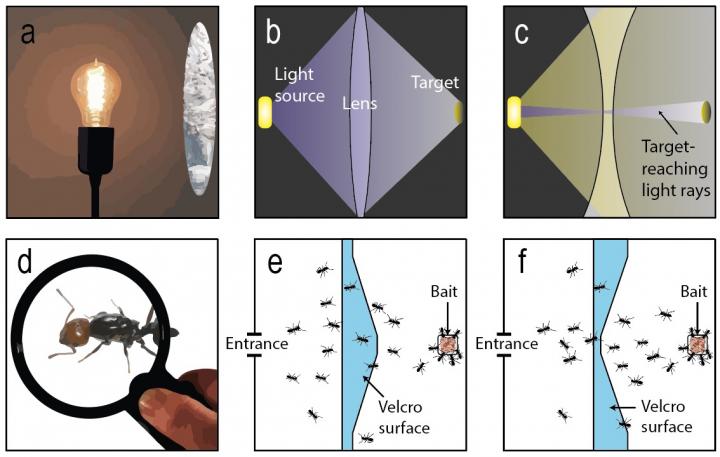
Credit: Choi J, Lim H, Song W., Cho H., Kim HY, Lee SI, Jablonski PG.[(b, c, e, f are adapted and modified from Choi et al.
Light and foraging ants seem totally unrelated, but they have one thing in common: they travel along time-reducing paths. According to Fermat’s principle about the refraction of a ray of light, the light bends when it meets a matter with different refractive indices and travels through time-minimizing paths. Recently, similar behavior was reported in foraging ants in a lab setting: ants ‘bend’ their travel paths when they enter a substrate that slows them down. But would the ants behave similarly as the light passing through convex or concave lenses when they travel through impediments with lens-like shapes? A multidisciplinary team of researchers from Seoul National University (SNU) and DGIST in Korea, composed of ecologists and an engineer conducted experiments in the field to find out if the ants indeed behave similarly to the light.
The study has started with the following reasoning. Laws of optics predict that light rays reach the target on the other side of a convex lens by crossing the convex lens nearly everywhere; the crossing points can be quite far from the center of the lens (Fig. 1b). On the other hand, light rays cross the concave lens can reach the target only when it pass through the points near the center of the lens (Fig. 1e)
The researchers asked whether ants also show similar trends when they cross lens-shaped impediments, made of Velcro tape, during their foraging trips. On the Velcro “lens”, the ants cannot walk as fast as they can on normal, flat surface. The researchers put these “lenses” between the nest entrance and the food source near several colonies of the Japanese carpenter ants and observed what happened. It turned out that the trails of ants crossing the “convex lens” diverged away from the center more than they did on the “concave lens”. This means that more ants avoided the central thick part of convex impediment, and more ants walked through the central narrow part of concave impediment. This suggests that ants tend to avoid the parts of impediments that considerably slow them down.
This general similarity to the behavior of light crossing through convex and concave lenses is consistent with the idea that foraging ants, like light rays, use time-reducing paths. “I studied math and physics as an undergraduate, and this has helped me to come up with this research idea after I was exposed to the wonders of the behavior of ants by my Lab mate, Dr. Woncheol Song” says Ph.D. candidate Jibeom Choi, who conducted the experiments and created a mathematical model of ant behavior. Collaboration between a behavioral ecologist, Prof. Piotr Jablonski (Laboratory of Behavioral Ecology and Evolution, SNU) and a theoretical engineer, Prof. Hoyoung Kim (Microfluids & Soft Matter Laboratory, SNU), additionally highlights the multidisciplinary merit of this study. “This is an example of synergistic effect of multidisciplinary collaboration; by crossing the boundaries between disciplines, we have a fuller understanding of the natural world.”, remarks the integrative ecologist in the study, Prof. Sang-im Lee (Laboratory of Integrative Animal Ecology, DGIST), who has been actively pursuing multidisciplinary research at SNU and DGIST, and has been involved in research on ants for years.
There are, however, remaining questions to be solved. As pointed out by authors themselves, the behavior of individual ants on the Velcro impediment and its borders has not been thoroughly investigated and it may contribute to the observed pattern. Therefore, further studies should focus on the behavior of individual ants at the edges between different substrates.
###
Original paper can be found at https:/
Persons to contact:
Primary person to contact is Mr. Jibeom Choi: [email protected]
Senior authors’ contact information is: Sangim Lee, Piotr G. Jablonski; website: http://behecolpiotrsangim.
Media Contact
Mr. Jibeom Choi
[email protected]
Related Journal Article
http://dx.




